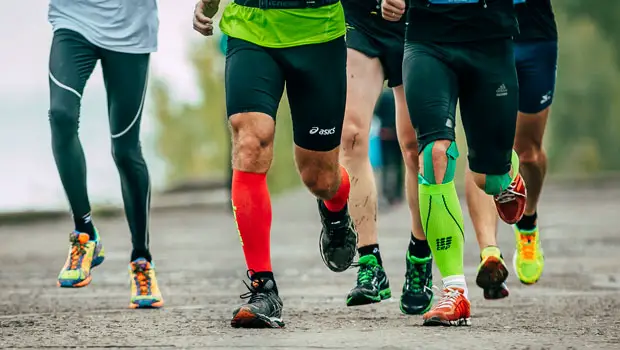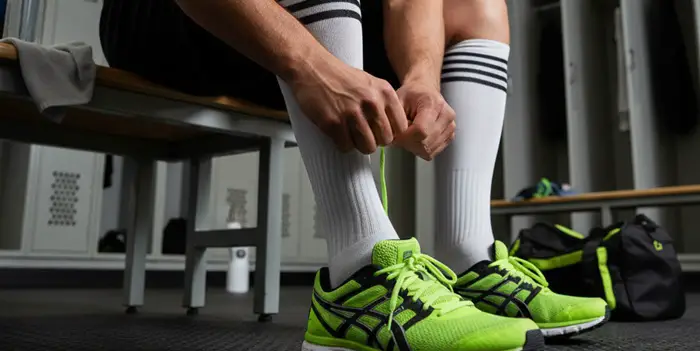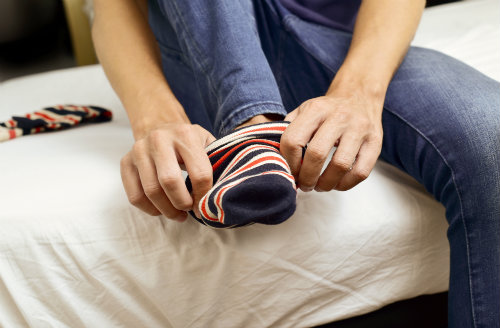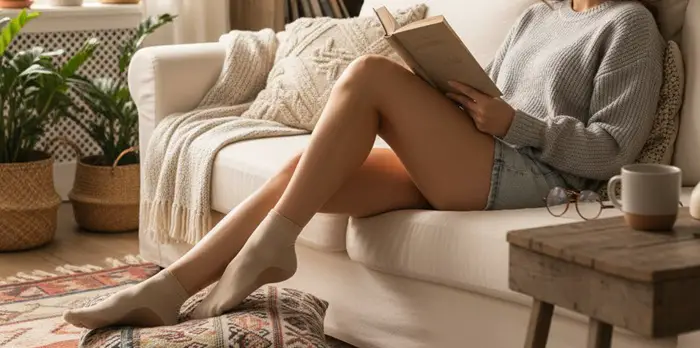
They’re invisible, practical, and a quiet revolution in modern footwear — no-show socks are the unsung heroes hiding beneath our favorite sneakers, loafers, or cut shoes.
Once seen as a purely fashion-driven choice, these low-cut wonders have evolved into a must-have blend of comfort, hygiene, and performance.
Whether you’re an active gym-goer, a minimalist dresser, or someone who just can’t stand the look of socks peeking out, no-show socks have something for everyone.
Let’s dive deeper into what makes these socks so special, the types available, and why your feet will thank you for wearing them.
Types of No-Show Socks
No-show socks come in several cuts, each crafted to suit different shoe styles, activities, and comfort needs.
Their construction involves thoughtful design — from moisture-wicking fibers to cushioned soles and elastic bands that keep them anchored below the ankle bone. Let’s look at the main types.
1. Casual No-Show Socks
These are your everyday essentials — thin, breathable, and perfectly suited for casual sneakers or loafers. Most are made of cotton blends or bamboo fibers, offering softness and moisture absorption.
A well-designed pair will include a cushioned sole and footbed, ensuring you stay comfortable during long walks without overheating.
Best for: Everyday wear, sneakers, slip-ons, and cut shoes.
Materials: Cotton, bamboo, elastane, or spandex for stretch.
2. Low-Cut Socks
A step above the truly “invisible” category, Low-Cut Socks sit just below the ankle.
They’re slightly more visible than casual no-shows but provide better coverage and protection — particularly around the heel and sides of your foot.
You’ll often find them equipped with elastic bands that hug the midfoot snugly, reducing slippage during motion.
Best for: Running shoes, training sneakers, or active wear.
Materials: Nylon blends, performance mesh, and padded terry loops for sweat control.
3. Tab No-Show Socks
Tab socks are the best-kept secret of serious runners. They include a small fabric tab at the heel — invisible once you wear shoes but perfectly placed to prevent rubbing or blisters.
The tab acts as a barrier between the shoe collar and your Achilles tendon, making them excellent for high-movement activities.
Best for: Athletic use, running, hiking, or workouts.
Materials: Synthetic performance fibers like polyester or Dry-Fit, with reinforced heels and toes.
4. Ultra-Low Cut Socks
If you’re wearing loafers or minimalist dress shoes, ultra-lows are your go-to. These are engineered to disappear completely inside your shoes while still offering protection and grip.
The inside usually has a silicone gel heel grip that keeps them from sliding down — essential if you’ve ever had your sock bunch under your arch mid-walk!
Best for: Dress shoes, loafers, moccasins.
Materials: Cotton-nylon blends with anti-slip silicone lining.
5. No-Show Liner Socks
These are as close as you can get to going barefoot without actually doing it. Designed with thin, silky materials, liner socks are ideal for tight-fitting shoes and warm climates.
Despite their delicate feel, good-quality versions still protect feet and ankles from chafing and bacterial buildup.
Best for: Ballet flats, loafers, low-profile sneakers.
Materials: Nylon, spandex, and microfiber.
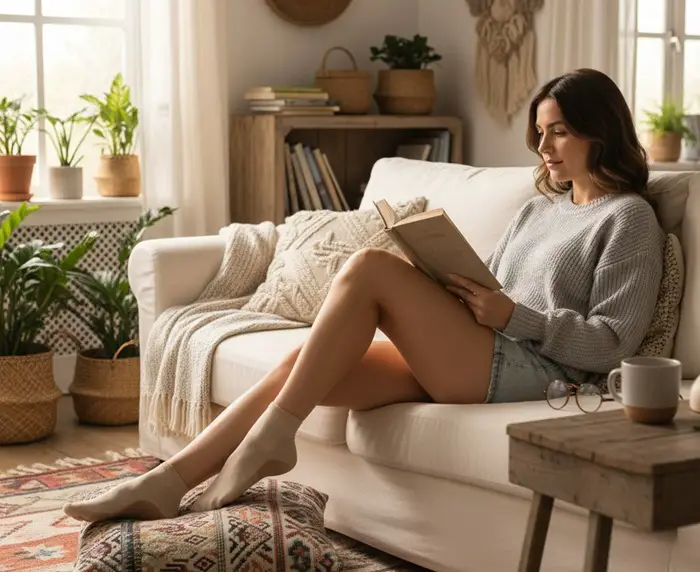
Benefits of Wearing No-Show Socks
No-show socks might look minimalist, but the benefits they provide are anything but.
From hygiene and comfort to foot health and style, they serve as an invisible yet essential line of defense for your feet.
1. Hygienic Footwear Experience
Sweat and shoes are a terrible combination — especially in warm climates.
Socks act as the first layer of defense, absorbing perspiration and preventing bacterial growth that leads to odor. No-show socks let you maintain hygiene without sacrificing a sockless look.
Bonus tip: choose bamboo or moisture-wicking technical fibers for naturally antibacterial protection.
2. Protection Against Friction and Blisters
Even the most premium cut shoes or sneakers can rub against your skin, especially around the ankle bone and heel.
No-show socks protect feet and ankles from chafing by adding a micro-layer of cushion that minimizes irritation.
The snug fit and smooth seams also help prevent rubbing from repetitive movement — especially useful if you’re on your feet all day.
3. Comfort with Every Step
Many modern no-show socks feature a cushioned sole and footbed, offering shock absorption and reducing pressure points.
This is particularly helpful for people with flat feet, plantar fasciitis, or arthritis, where even small amounts of padding can improve daily comfort and foot alignment.
Good socks distribute pressure evenly and prevent fatigue during long hours of standing or walking.
4. Improved Foot Health
Socks are not just fashion accessories — they’re small health investments. By wicking away moisture, they help reduce fungal infections like athlete’s foot.
They also maintain the microclimate inside your shoes, keeping your feet dry and cool, which is beneficial for people with arthritis or circulation issues.
Some orthopedic no-show variants even provide mild arch support for people with flat feet.
5. Style Without Compromise
The biggest advantage of no-show socks? They let your shoes do the talking.
Whether you’re wearing loafers, espadrilles, or casual sneakers, these socks stay invisible — maintaining that clean, elegant, “sockless” look without actually being sockless.
They’re ideal for modern minimalists who prefer form and function to coexist peacefully.
6. Reduced Shoe Odor and Wear
Without socks, sweat and oils from your feet get absorbed directly into your shoe lining, leading to odor and faster material breakdown.
A thin no-show barrier prevents this, extending the lifespan of your footwear. It’s like using a breathable shield that keeps your favorite shoes fresher for longer.
7. Versatility for Every Occasion
From boardrooms to treadmills, no-show socks fit almost every lifestyle.
They pair perfectly with active wear for gym sessions and blend seamlessly with formal shoes for office settings. This adaptability makes them a smart investment — one that serves both aesthetics and utility.

How to Keep Your Low-Cut Socks from Slipping?
Let’s be honest — the biggest complaint about no-show socks is that they sometimes slip off mid-stride, bunching up under your arch like an annoying paper ball. The solution lies in smart design and smart selection.
- Choose the Right Fit: Always match the sock size to your shoe size. Oversized socks tend to slide.
- Look for Silicone Heel Grips: A quality no-show sock has anti-slip silicone pads inside the heel to anchor them in place.
- Elastic Band Support: A well-placed elastic band across the midfoot ensures the sock clings without constricting.
- Material Matters: Synthetic blends like spandex and nylon maintain elasticity longer than 100% cotton.
- Replace Worn-Out Pairs: Once the elastic loosens, no amount of wishful thinking will keep them up. Retire old pairs gracefully.
In short, buy quality once, cry less later.
What’s the Difference Between No-Show Socks and Ankle Socks?
Though often confused, these two are quite different species in the sock world.
No-Show Socks are designed to stay completely invisible inside most shoes. They sit well below the ankle bone and are perfect for dress shoes or loafers where you don’t want any fabric showing.
Ankle Socks, on the other hand, rise just above the ankle and provide a bit more coverage and protection.
They’re ideal for running or training since they prevent shoe collars from rubbing against your skin.
In short:
- No-Show = Fashion and minimalism
- Ankle Socks = Function and protection
Think of it as choosing between stealth and armor — both have their place, depending on what your feet are getting into that day.
When Can You Go Sockless? (Wearing Shoes and Boots with No Socks)
There’s something undeniably cool about the bare-ankle look — especially with tailored pants and loafers. But while going sockless might win you style points, it’s not always the healthiest choice.
You can go sockless:
- With breathable loafers or canvas shoes designed for it.
- For short, casual outings or summer wear.
- If you use moisture-absorbing insoles or sprays.
You shouldn’t go sockless:
- For extended wear in leather or synthetic shoes (they trap sweat).
- During workouts — sweat and friction can cause blisters fast.
- If you’re prone to foot odor, fungal infections, or sensitive skin.
The smart middle path? Wear no-show socks. You’ll still get that stylish, clean look while your feet remain dry, cushioned, and healthy.
Final Thoughts
No-show socks may not get the spotlight they deserve, but they’re one of the smartest wardrobe upgrades you can make.
They let your shoes shine, keep your feet healthy, and make every step feel a little more luxurious.
Whether you prefer Casual No-Show Socks, Low-Cut Socks, or Tab No-Show Socks, the right pair will make your footwear fit better and your day feel smoother.
So, the next time someone tells you they’re going “sockless,” give them a knowing smile. Because real comfort — like the best socks — doesn’t always need to be seen to be appreciated.

